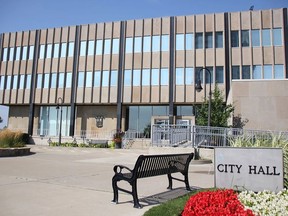Without a development charges by law in place, expect Sarnia taxpayers to pay the difference for growth-related city projects, such as major roadways and pumping stations, the city’s top engineer says.

Without a development charges by law in place, expect Sarnia taxpayers to pay the difference for growth-related city projects, such as major roadways and pumping stations, the city’s top engineer says.
Advertisement 2
Article content
“Any shortfall we have there, that would be (made up) through property taxes or through water or sewer fees,” when future city budgets are set, said David Jackson, after city council recently agreed to let the existing development charges by law expire Dec. .31.
Article content
In November, council opted – at the urging of the Sarnia-Lambton Association of Realtors – to delay implementing a new bylaw a consultant has said would hike rates about 30 per cent.
The aim is more time for expert analysis to make sure the proposed rate hikes are the right amount, board president Rob Longo has said.
But the proposal, to extend the current bylaw until March 31, isn’t allowed under the provincial Development Charges Act, city officials told council Dec. 11, urging council to reconsider its November decision, pass the new bylaw, and leave it open to amendment following further consultation.
Advertisement 3
Article content
Only councilors Bill Dennis, George Vandenberg, Dave Boushy, Adam Kilner and Brian White, who voted in favor in November of extending public input to March 31, were eligible to make a motion to reconsider.
None did. White was absent.
“So, as of Jan. 1, we have no DC bylaw in place, which means we have no mechanism then to collect development charges,” Jackson said.
That means any projects started while there’s no bylaw won’t pay development charges, he said, because the bylaw only allows collecting those charges at a prescribed moment in time.
When specifically wasn’t clear, but it’s either at the permitting stage or relatively early in the process, he said.
“So, once they’ve started their project and are building away, we don’t have a mechanism to come and recover that cost from them,” Jackson said.
Advertisement 4
Article content
How much that affects city coffers depends on what gets approved when there’s no bylaw, he said.
“If there’s a few single-family home permits, it’s not a significant amount; if there’s a large apartment building development, then it would be a larger amount,” he said.
Between January and March 2023, there were 109 permits issued for residential, commercial, industrial and other projects with a $14.8 million construction value.
Of those, 14 were for residential, accounting for about a third of the construction value.
A report on more specific impacts of the bylaw’s absence is expected in January.
Council was next scheduled to meet Jan. 15, but on Thursday – a day after this story first appeared online – the city announced a special council meeting had been called for Dec. 19.
Advertisement 5
Article content
A notice of motion has been submitted by Kilner to reconsider the development charges by law decision, the city update says.
Having the bylaw expire and a void ensue wasn’t the aim of asking for a bylaw extension, Longo said.
“I wasn’t trying to kill their bylaw,” he said, adding he’s confident the city will do something to correct the situation soon.
One option could be implementing a new bylaw using the current rates as a placeholder, he said.
If however, the municipality remains without a development-charge bylaw until the spring, there could be a rush of developers in March, he said, trying to take advantage of lower costs.
“Obviously with development, things aren’t that instantaneous where you can all of a sudden have plans and blueprints,” he said, so a shorter window wouldn’t make as much of an impact.
Advertisement 6
Article content
Residential development charges currently range from $19,000 for most places in the city to $36,000 in development area two, and would have risen to a range from $21,000 to about $43,000, the draft says.
Development charges are sometimes misunderstood, Jackson said.
Builders take care of the costs of roads, sewers, water mains, street lights and other aspects of new subdivisions; “but development charges fund the larger capital projects that benefit the whole growth area,” he said.
For development area two in the city’s southeast, for instance, the city needs to build pumping stations, new arterial roads and stormwater management ponds, he said.
Money from development charges helps cover those project costs.
Advertisement 7
Article content
“The reason you have development charges is the concept that growth should pay for growth,” Jackson said. Otherwise, it falls to ratepayers across the city.
Costs have gone up about 48 per cent for city infrastructure projects since the last development charges by law were crafted about five years ago, he said.
Even with the rates increasing, revenue loss for the city is expected under the new charges structure because of provincial rules requiring development charges be paid in phases, consultant Daryl Abbs, of Watson and Associates, has said.
But Sarnia’s proposed rates are multiple times more expensive than other municipalities in Lambton County, Longo claimed.
Worries are higher rates in Sarnia will push builders and development to those other municipalities instead, and Sarnia’s population growth will suffer, he has said.
He added Wednesday he welcomes and is grateful for the extra time to review the new rates.
“The homebuilders’ association and the association of realtors are working toward gathering more information, and … as we have more, we’ll keep everyone updated,” he said.
Update: This story has been updated to include announcement of Dec. 19 special city council meeting.
Article content